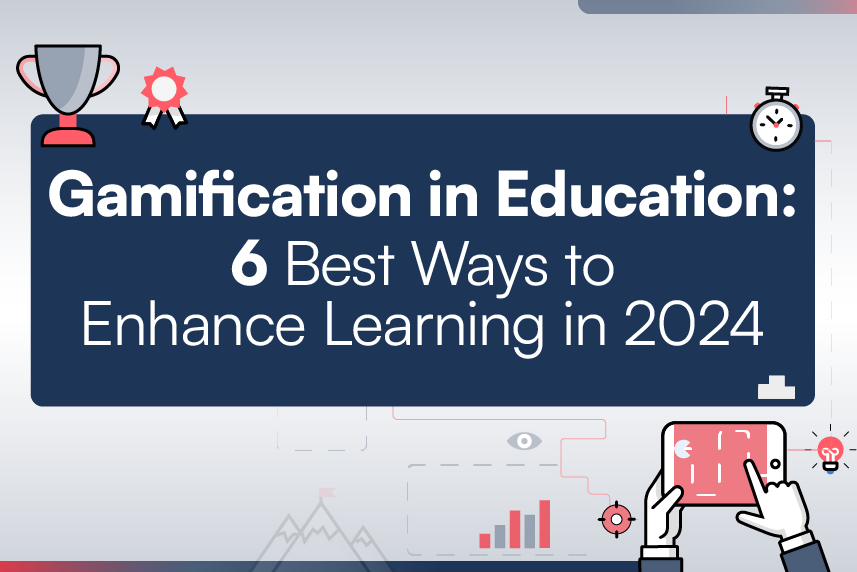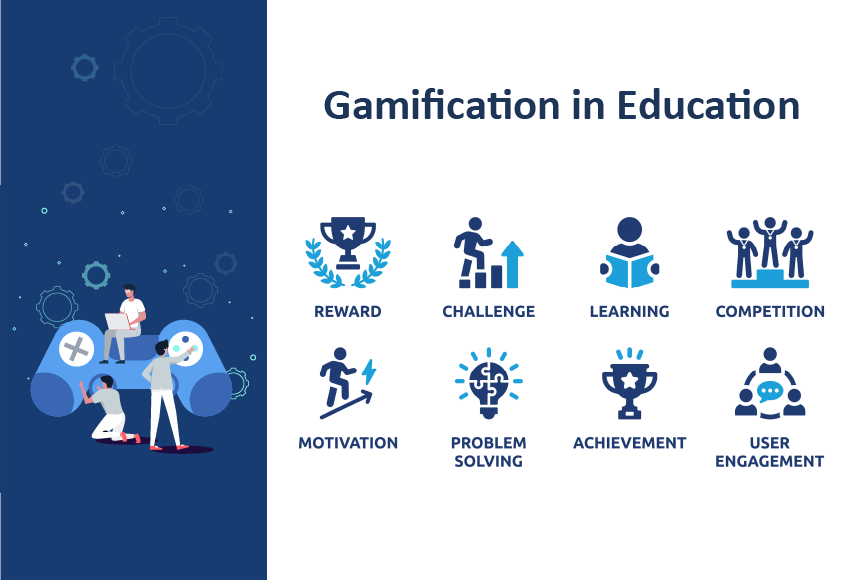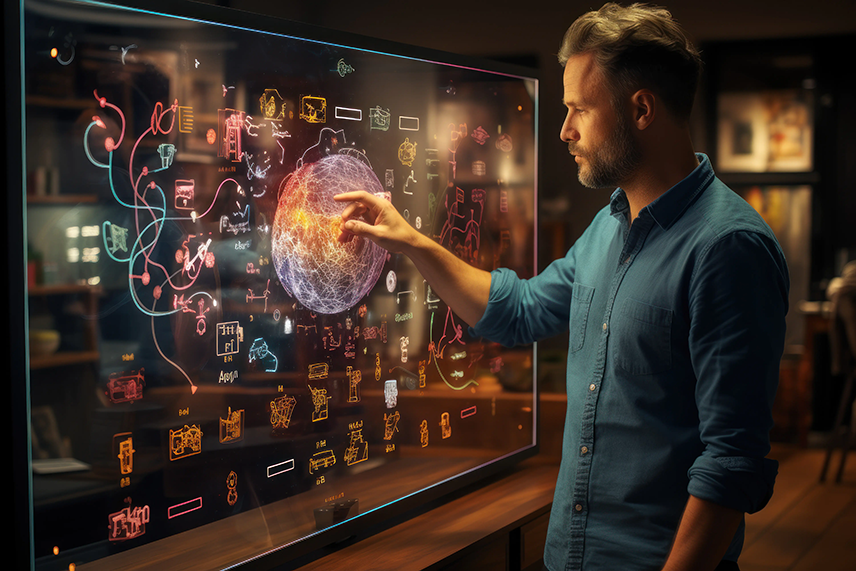
Gamification in education presents a strategic frontier to create immersive and effective learning experiences. It can help global product and technology companies build leading EdTech products that not only break down traditional educational barriers but also improve engagement, personalization, and knowledge retention.
According to Science Direct, challenge-based gamification improved student performance by 89.45% compared to lecture-based education. This statistic truly underscores the transformative impact of incorporating game elements in education.
Whether you want to create learning analytics software, advance skilling platform for student development, or streamline online program management, gamification can be your best bet. But how to utilize the capabilities of gamification and make the most of it?
This blog post will help you explore the most effective ways to use gamification in education in 2024. You will also get valuable insights into why gamification in education has become the need of the hour. Let’s start.
Why Use Gamification in Education: 6 Critical Benefits to Consider
Gamification has moved beyond being a mere buzzword. It has become a pivotal strategy to create a lasting impact in the world of education. Here are some compelling reasons to leverage gamification in education and maximize business outcomes.
1. Build Engaging and Interactive Products
Gamification in education serves as a powerful catalyst for student engagement and motivation. Software, product, and technology companies can integrate game elements into education content to develop appealing and dynamic EdTech products.
They can create effective learning solutions to captivate and retain the attention of students, ultimately contributing to better education outcomes. The inherent competitive nature of gamification can stimulate a sense of achievement and make the education journey more enjoyable than ever.
2. Create Personalized Learning Journeys
Gamification enables a more personalized approach to education. It facilitates a more inclusive and practical learning experience for students across various skill levels. It can cater to students’ learning styles and preferences by tailoring content based on individual progress and performance.
Product development companies can design adaptive gamified systems that can promote self-paced learning and skill development. This personalization not only accommodates diverse learning needs but also ensures that learners stay engaged.
On the other hand, skilling platforms can leverage gamification to offer personalized learning paths based on individual skills gaps and career aspirations. They can enhance student productivity, boost their problem-solving abilities, and align educational content with specific learning goals.
According To Zippia, Gamification In Education Can Improve Student Productivity By 50% And Student Test Scores By 34%.
3. Get Data-Driven Insights
Using gamification provides valuable data and insights into student participation, learning behaviors, and assessment impact. Global skilling platforms can use these insights to fine-tune their education offerings. They can ensure their education solutions remain relevant and effective in the ever-changing skill development landscape.
Online program managers can benefit from the data generated by gamified education systems. Insights into student performance, engagement levels, and preferred learning styles allow for data-driven decision-making. This information can also be crucial for refining course content, optimizing learning pathways, and ensuring the overall effectiveness of education programs.
4. Align with Modern Learning Preferences

In today’s tech-driven era, students are strongly inclined toward interactive and dynamic learning experiences. Gamification seamlessly integrates technology into education, catering to the modern learning preferences of students.
By integrating gamified elements, software development companies can create an environment that resonates with the modern learner. They can leverage gamified features such as leaderboards, badges, and challenges to instill a sense of competition and achievement and increase participation and interest in education content.
Gamification in education not only aligns with technological preferences but also enhances the competitive aspect of learning. Skilling platforms can use gamification to introduce practical and interactive learning opportunities and reinforce the application of acquired skills in real-world scenarios.
5. Develop Different Types of Education Content
Implementing gamification in education positively impacts student engagement, learning outcomes, and content delivery. Gamification can be applied to multiple types of educational content. Be it coding exercises, language learning programs, or skill development courses.
Skilling platforms can leverage gamification to develop multiple types of educational content for students. They can offer a dynamic range of content that caters to different learning styles, from simulations and quizzes to interactive scenarios and virtual challenges.
6. Enhance Agility in Learning Design
Online program managers can embrace gamification to enhance agility in learning design. They can use gamification to introduce a dynamic and flexible approach to education content delivery and quickly adapt to changing educational needs. They can incorporate game elements such as challenges, rewards, and interactive simulations to create a more scalable and responsive learning environment.
They can swiftly update content, address learner feedback, and optimize the learning experience. They can find out areas of strength and weakness, allowing for targeted adjustments in learning design. This iterative feedback loop enhances the adaptability of online programs, ensuring that they remain relevant and effective.
How to Use Gamification in Education: Top 6 Ways to Adopt in 2024
Now that you know the benefits of using gamification in education, let’s move forward to understanding how you can utilize it to build a robust future of education framework. Explore the most effective ways of implementing gamification in education that will not only elevate your EdTech success quotient but also help you accelerate your digital transformation journey.
1. Interactive Learning Modules
A significant way to introduce gamification in education is through interactive learning modules. These modules breathe life into traditional lessons by converting them into captivating experiences. They leverage game-like elements, transforming historical events into exciting quests and mathematical problems into challenging puzzles.
Learners actively engage with the content, fostering a more profound understanding through hands-on participation. This approach not only makes education enjoyable but also enhances retention as students navigate through scenarios, applying knowledge in a context that mirrors real-world problem-solving.
2. Collaborative Challenges
Collaborative challenges promote teamwork and communication skills by encouraging students to tackle problems collectively and attain shared objectives. Through activities requiring joint efforts, students develop a sense of camaraderie and hone critical thinking and problem-solving abilities.
3. Reward System
Another way to use gamification in education is by introducing a reward system. This system instills motivation and celebrates students’ accomplishments in the learning journey. This system inspires continuous improvement and mastery by incorporating elements like badges, leaderboards, and other virtual incentives.
Students are motivated to participate actively, as each achievement becomes a steppingstone toward success. The tangible rewards recognize their efforts and create a positive reinforcement loop, encouraging a sustained and enthusiastic approach to the educational process.
4. Real-World Simulations

Adopting real-world simulations is an essential approach to using gamification in education. It can elevate learning by immersing students in practical, hands-on experiences. From managing virtual tasks to conducting scientific experiments and navigating historical events, these simulations bridge the gap between theory and application.
Placing students in dynamic, real-world scenarios gives them a deeper understanding of complex concepts, honing problem-solving skills, and critical thinking. This immersive approach makes learning more tangible and prepares students for the challenges they may encounter in their future academic and professional pursuits.
5. Competitive Quizzes
Competitive quizzes inject excitement into learning by introducing friendly competition. Whether students engage individually or in teams, this approach sparks a healthy rivalry that motivates them to learn and acquire knowledge. As they strive to outperform their peers, the thrill of competition enhances engagement and encourages a more thorough understanding of the subject matter.
Competitive quizzes play an essential role in integrating gamification in education. They can successfully transform the educational experience into an interactive and stimulating journey of discovery and achievement.
6. Progress Tracking and Feedback
Developing progress tracking and feedback mechanisms is one of the most crucial techniques to implement gamification in education. This technique helps create visual progress indicators, such as progress bars and milestones, that clearly represent accomplishments and foster a sense of achievement.
Real-time feedback on quizzes and assignments ensures an immediate understanding of mistakes or successes, contributing to a dynamic learning experience. Encouraging students to set personal goals and reflecting on their progress adds a metacognitive layer, promoting autonomy and self-awareness.
Explore the top 9 EdTech trends 2024 that can take your gamification strategies to the next level and shape the future of education. Establish a more sustainable and inclusive education system to successfully meet the evolving needs of students and educators.
Time to Start Using Gamification in Education
Leveraging gamification in education delivers student-centric knowledge and revolutionizes the learning experience like never before. Integrating game elements into education practices emerges as a beacon of innovation and learning excellence.
Global software, product, and technology companies can take full advantage of gamification to build interactive interfaces, gamified teaching platforms, and advanced learning solutions. Contrarily, online program managers and skilling platforms can gamify education processes to facilitate skill acquisition, create and curate skill-based programs, and optimize their education offerings.
If you want to harness the true potential of gamification in education, reach out to us at contact@harbingergroup.com. Our EdTech experts would be more than happy to help you achieve your desired business goals.






